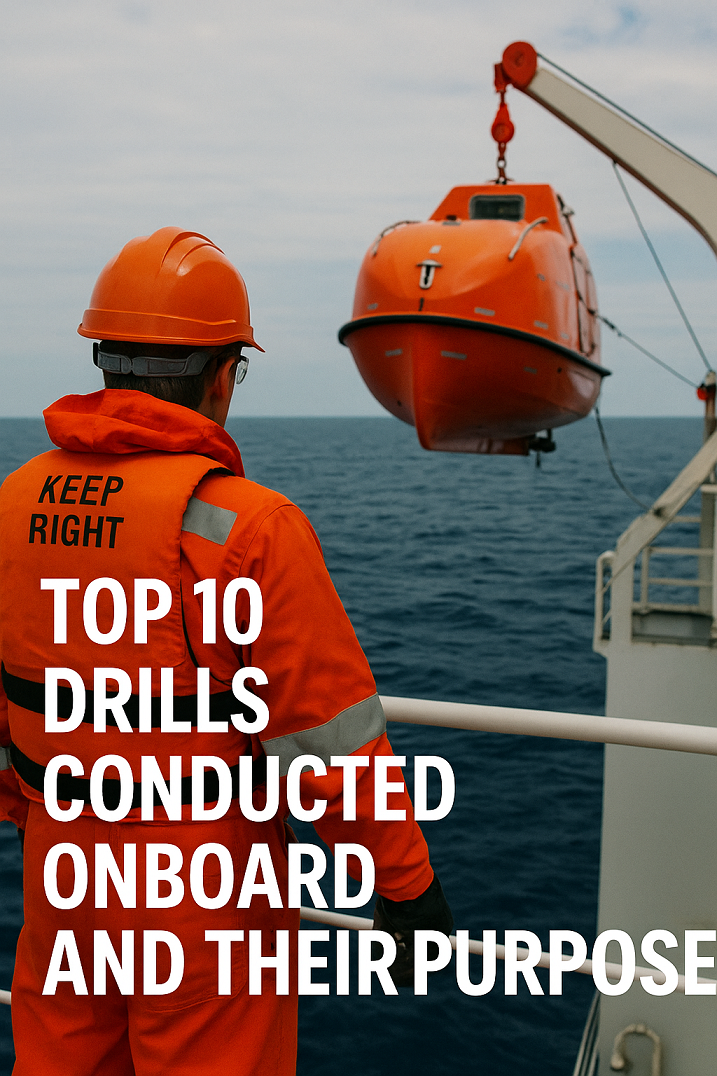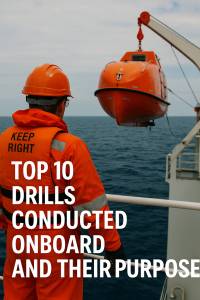Discover the top 10 onboard drills that safeguard life and ship at sea. Learn the purpose of each drill, how they’re conducted, and their role in modern maritime safety and compliance.
Why Onboard Drills Matter in Modern Maritime Operations
The sea is one of the most demanding environments in the world. When emergencies strike—whether it’s fire, flooding, piracy, or a man overboard—there’s no fire department to call, no roadside assistance. The crew is the first and only line of defense. That’s why regular onboard drills are not optional—they are mandatory, life-saving exercises that prepare crews for the unexpected.
Under SOLAS Chapter III and the ISM Code, drills are a cornerstone of shipboard safety management. Their purpose isn’t to tick a regulatory box but to create muscle memory and mental readiness that can be the difference between chaos and control.
This article explores the top 10 drills conducted onboard ships, explaining not only their procedures but also the real-world scenarios that make them essential.
Understanding Maritime Drills: A Regulatory and Practical Perspective
The International Maritime Organization (IMO) mandates drills as part of shipboard emergency preparedness under the Safety Management System (SMS). The STCW Convention also requires all seafarers to demonstrate competence in emergency procedures through both training and practice.
Drills must be:
-
Conducted at regular intervals (weekly, monthly, or quarterly)
-
Logged and reviewed during audits
-
Evaluated for effectiveness and crew participation
1. Fire Drill
Purpose: To train the crew in fire detection, response, containment, and evacuation procedures.
What It Covers:
-
Operation of fire alarms and extinguishers
-
Use of firefighting gear and SCBA (Self-Contained Breathing Apparatus)
-
Mustering and command chain
-
Search and rescue of trapped personnel
Real-World Relevance: In 2022, a fire aboard a bulk carrier in the Indian Ocean was extinguished with zero injuries, thanks to recent and well-practiced fire drills conducted just days prior.
Regulation: Required weekly under SOLAS (Chapter III, Reg. 19).
2. Abandon Ship Drill
Purpose: To ensure the crew can safely evacuate the vessel using lifeboats, life rafts, and PPE.
Key Actions:
-
Donning lifejackets and immersion suits
-
Launching and boarding lifeboats
-
Communicating with shore and nearby vessels
-
Starting lifeboat engines and navigating short distances
Analogy: Just like airline cabin crew practice emergency exits and raft deployment, ship crews must rehearse abandonment to avoid panic.
Frequency: At least once a month; often combined with fire drills.
3. Man Overboard (MOB) Drill
Purpose: To train the bridge and deck teams in recovering a person who has fallen into the sea.
Procedure Includes:
-
Raising alarms and announcing MOB
-
Immediate visual contact and marking position
-
Maneuvering vessel for rescue (Williamson Turn or Anderson Turn)
-
Lifebuoy and rescue boat deployment
Critical Detail: Cold water shock and drowning can occur within minutes. Rapid response is vital.
Regulation Basis: SOLAS & STCW safety familiarization requirements.
4. Enclosed Space Entry and Rescue Drill
Purpose: To ensure the crew can safely enter and retrieve personnel from oxygen-deficient or toxic environments (e.g., ballast tanks, cargo holds).
Includes:
-
Risk assessment and entry permits
-
Ventilation and gas detection procedures
-
Use of breathing apparatus
-
Standby person communication and rescue readiness
Stat: According to EMSA, over 60% of fatalities in enclosed space incidents involve rescuers not trained in proper entry procedures.
Frequency: Every 2 months (SOLAS Regulation III/19.3.6.2).
5. Oil Spill Response Drill
Purpose: To simulate response to oil pollution incidents in line with MARPOL Annex I and the Shipboard Oil Pollution Emergency Plan (SOPEP).
Involves:
-
Deployment of oil spill booms and sorbents
-
Use of pumps and skimmers
-
Communication with port authorities and cleanup contractors
Real-World Note: Ships carrying oil must test their SOPEP plan annually, but many proactive companies conduct quarterly tabletop drills.
6. Security Drill (ISPS Code Compliance)
Purpose: To prepare for ship security threats, such as piracy, stowaways, or terrorism.
Simulations May Include:
-
Raising Security Levels
-
Lockdown of restricted areas
-
Anti-piracy watch routines
-
Emergency communication protocols
Case Study: A successful anti-piracy response drill in the Gulf of Aden in 2021 prevented the hijacking of a chemical tanker by deterring intruders with early alarms and evasive maneuvering.
Frequency: Every 3 months per ISPS Code Part A/18.5.
7. Flooding or Damage Control Drill
Purpose: To train the crew in managing hull breaches, compartment flooding, and structural failure.
Drill Activities:
-
Sounding tanks and bilges
-
Using portable pumps and watertight door closures
-
Operating valves and emergency power
Key Point: Time is critical; rapid response can prevent loss of buoyancy or progressive flooding.
8. Emergency Steering Drill
Purpose: To ensure manual steering and alternative control systems are functional and understood by the crew.
Involves:
-
Testing emergency steering gear in steering gear room
-
Communication between bridge and steering team
-
Manual override and isolation of autopilot
Requirement: SOLAS Chapter V, Regulation 26 mandates that drills be conducted at least once every 3 months.
9. Blackout and Emergency Generator Drill
Purpose: To test backup power systems and train crew to operate under total power failure.
Drill Includes:
-
Simulating a full blackout
-
Automatic or manual starting of the emergency generator
-
Manual operation of key equipment (e.g., steering, fire pumps)
Importance: A blackout during navigation or port operations is one of the most dangerous scenarios. Drills reduce chaos and ensure system familiarity.
10. Helicopter Rescue or Medevac Drill
Purpose: Though not mandated on all ships, this drill is critical for high-risk areas or offshore operations.
Simulations Cover:
-
Preparing a helideck or winching zone
-
Communication with rescue helicopter
-
Securing the patient for transfer
-
Medical response and casualty handling
Recommended For: Tankers, offshore supply vessels, cruise ships, and Arctic/remote voyages.
Real-World Applications: The Norman Atlantic Case
In 2014, the Norman Atlantic ferry caught fire in the Adriatic Sea. Investigations revealed poorly conducted drills and unfamiliarity with lifeboat launching procedures. As a result, rescue operations were delayed, and over 30 lives were lost. This tragic incident reinforced the need for drill realism and crew-wide involvement.
FAQ: Drills Onboard Ships
Q1: Are all drills mandatory under SOLAS?
A: Most are. Fire, abandon ship, and enclosed space entry drills have defined frequencies under SOLAS and ISM Code.
Q2: Who supervises onboard drills?
A: The Master or designated officer (usually the Safety Officer or Chief Mate) leads and logs all drills.
Q3: Can drills be combined?
A: Yes. Fire and abandon ship drills are often combined to optimize time, but each component must be completed fully.
Q4: How are drills recorded?
A: In the Deck Logbook and Drill Record Log, including date, type of drill, participants, and any deficiencies noted.
Q5: What happens if a ship fails to conduct drills regularly?
A: Port State Control can issue deficiencies, detentions, or fines. Non-compliance also affects a vessel’s safety audit scores.
Q6: Are cadets or trainees required to participate?
A: Absolutely. All persons on board must participate in drills as part of shipboard familiarization and STCW compliance.
Conclusion
In maritime operations, complacency is the enemy of safety. Drills onboard are not rehearsals—they are lifelines. They prepare crews to respond with precision, confidence, and speed when disaster strikes.
Whether it’s launching a lifeboat in rough seas or rescuing a crewmate from an enclosed tank, a well-drilled crew is a safe crew. These top 10 drills are the foundation of that safety.
Call to Action: Want detailed drill checklists, log templates, or training videos? Visit our Maritime Safety Drill Resource Center to strengthen your crew’s readiness.
References
-
International Maritime Organization. (2020). SOLAS Consolidated Edition. https://www.imo.org
-
Paris MoU. (2023). Annual Report on Port State Control. https://www.parismou.org
-
EMSA. (2022). Enclosed Space Fatality Report. https://emsa.europa.eu
-
International Chamber of Shipping. (2021). Guidelines on Fire and Abandon Ship Drills. https://www.ics-shipping.org



Thanks for every other informative blog. Where else may I am getting that type of information written in such an ideal manner? I have a mission that I am simply now operating on, and I have been on the glance out for such information.